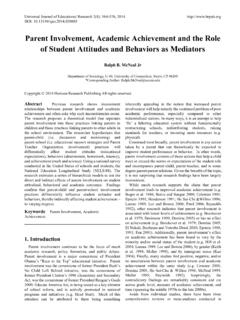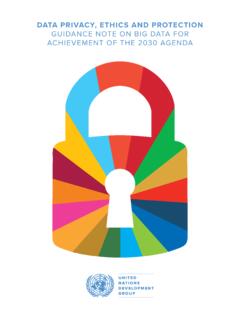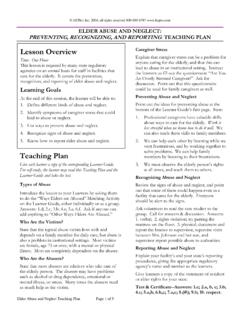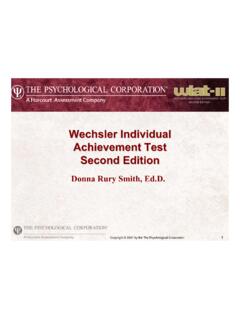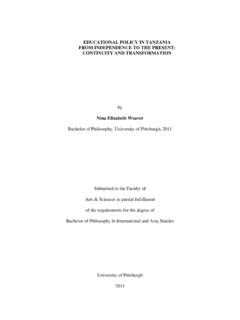Transcription of Recognizing - ed
1 64 KAPPA DELTA PI RECORD WINTER 2006 Recognizing Gifted Students: A Practical Guide for Teachersby Sandra Manning64 KAPPA DELTA PI RECORD WINTER 2006By watching for certain behaviors and characteristics, teachers in the general education classroom can identify and better understand exceptional DELTA PI RECORD WINTER 2006 65 Sandra Manning is Associate Director for The Frances A. Karnes Center for Gifted Studies at The University of Southern Missis-sippi. Her research interests include young gifted children and differentiating instruction for high ability students.
2 She also holds National Board Teacher Gifted Students: A Practical Guide for Teachers Gifted students routinely exhibit academic and emotional traits that may be described as intense and, at times, even extreme. Today, more than ever, student diversity typifies the general education classroom (Tomlinson 2004). In most classrooms, the range of cognitive abilities is vast. Inclusion and legislative mandates challenge general educators to design and implement teaching and behavior management strategies that will ensure success for all student groups including the gifted and highly able.
3 Research indicates, however, that a majority of teachers have little specific knowledge about this group of children (Archambault et al. 1993; Robinson 1998; Westberg and Daoust 2003; Whitton 1997).Lacking awareness of the characteristics and instructional requirements of high ability students, teachers are at a disadvantage. This article explores the characteristics of gifted children and offers the general classroom teacher tips and ideas for understanding the gifted children they Gifted High ability students have been labeled in many ways.
4 Currently, the label gifted is used to indicate high intellectual or academic ability, and gifted education is recognized as the educational field devoted to the study of this student population. However, defining gifted is no easy task. The earliest use of this word to identify high ability students was by Lewis Terman in 1925 (Stephens and Karnes 2000; Morelock 1996). This usage came on the heels of the first IQ test developed in the early 1900s by Alfred Binet (Morelock 1996; Morgan 1996; Sarouphim 1999). Terman identified students scoring in the top 2 percent in general intelligence on the Binet test or a similar measure as gifted (Clark 2002).
5 Over the years, many definitions of this term have been proposed by scholars and researchers. From natural talent awaiting development (Gagne 1995; Tannenbaum 2003) to the ability to use life situations successfully (Sternberg 2003), the common factors in defining giftedness appear to be potential and (2002) defined gifted as a label for the biological concepts of superior development of various brain functions. These functions, according to Clark, may be manifested in the areas of cognition, creativity, academics, leadership, or the arts.
6 Clark subtly emphasized the natural aspects of the child s ability, as opposed to learned aspects, and most nearly matched the popular definition of the word gifted endowed with a special aptitude or ability (Webber 1984, 295). Clark (2002, 25), however, went on to say that Growth of intelligence depends on the interaction between biological inheritance and environmental opportunities. With this phrase, Clark inferred a union of the nature/nurture debate, designating giftedness as partially due to inherited traits of information processing with an integral portion attributed to the environmental experiences the child encounters to develop those formal definitions of the word gifted include those offered by parent groups and gifted students themselves.
7 Russell, Hayes, and Dockery (1988, 2) reported a definition created by a parent group: Giftedness is that precious endowment of potentially outstanding abilities which allows a person to interact with the environment with remarkably high levels of achievement and creativity. Gifted student Amanda Ashman (2000, 50) defined being gifted as not 66 KAPPA DELTA PI RECORD WINTER 2006 something that you can develop. You are born with a capacity for knowledge. Learning and understanding come naturally for the gifted. These definitions further the meaning of giftedness as an endowment of natural ability apart from learning that takes place in the home or at school.
8 Unfortunately, these types of definitions have given the field of gifted education the reputation of elitism (Morelock 1996) and perhaps have been the impetus of the popular myth that gifted students will get it on their own. To refute that myth and highlight the need for talent development in all students, growing interest in the idea of multiple intelligences has challenged the singular idea of general intelligence or g (Gardner 1983; Von K rolyi, Ramos-Ford, and Gardner 2003) and suggested that strengths in many areas more aptly define giftedness in individuals.
9 Further, Sternberg (2003) advocated in his theory of successful intelligence that giftedness is manifested in individuals who are able to take the raw materials of their life situations and transform them into successful experiences. Renzulli (1978; 2003) added that task commitment and creativity must be considered when defining giftedness is inherited, developed, manifested in the ability to manipulate life situations, or a result of some combination of these ideas, it is imperative for the regular classroom teacher to be cognizant of the fact that high ability students are in the classroom.
10 Because these students are present, teachers have a responsibility to create a learning environment conducive to gifted student of Gifted StudentsOne key way classroom teachers can broaden understanding of gifted students is through knowledge of the general characteristics intellectually gifted children exhibit. Characteristics in the cognitive and affective domains most commonly appear in general classroom behavior and, therefore, may be observed by the classroom teacher. Table 1 highlights general cognitive characteristics of intellectually gifted students.











